2015 Alfa Romeo Giulietta warning light
[x] Cancel search: warning lightPage 126 of 288
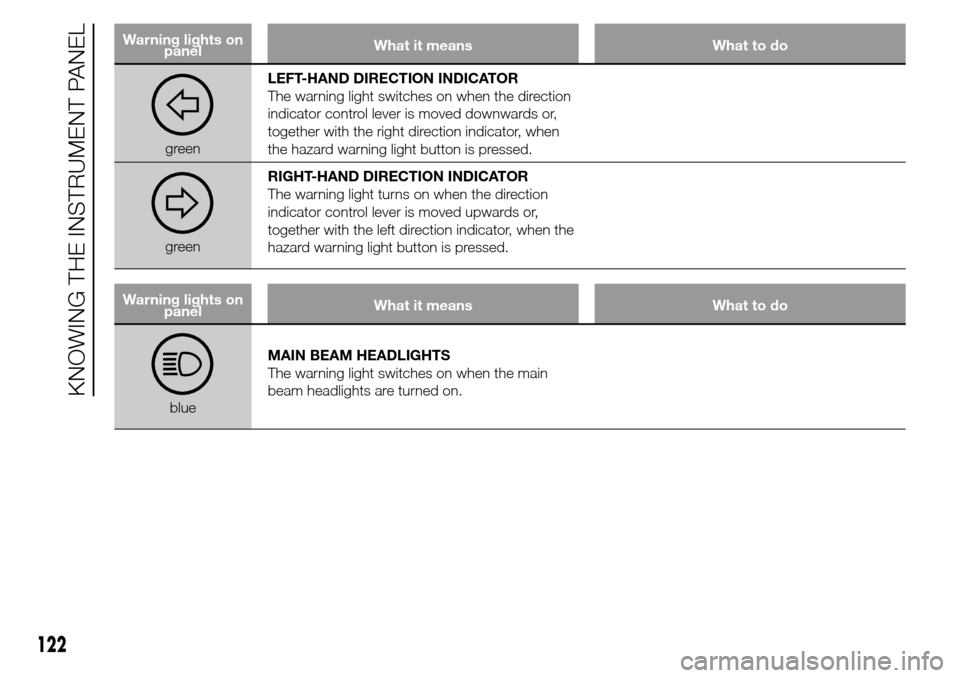
Warning lights on
panelWhat it means What to do
greenLEFT-HAND DIRECTION INDICATOR
The warning light switches on when the direction
indicator control lever is moved downwards or,
together with the right direction indicator, when
the hazard warning light button is pressed.
greenRIGHT-HAND DIRECTION INDICATOR
The warning light turns on when the direction
indicator control lever is moved upwards or,
together with the left direction indicator, when the
hazard warning light button is pressed.
Warning lights on
panelWhat it means What to do
blueMAIN BEAM HEADLIGHTS
The warning light switches on when the main
beam headlights are turned on.
122
KNOWING THE INSTRUMENT PANEL
Page 133 of 288

72) Make sure that the backrest is
correctly secured on both sides
("red bands" B fig. 108 not visible)
to prevent it from moving forward
in the event of sharp braking,
causing injuries to occupants.SBR SYSTEM (Seat
Belt Reminder)
This system comprises an acoustic
warning which, in conjunction with the
warning lights flashing on the
instrument panel, advises the front seat
passengers if their seat belt has not
been fastened.
On some versions there is also a panel
(provided as an alternative to the
warning light on the instrument panel)
located above the interior rear view
mirror, which warns the front and back
seat passengers through acoustic
and visual signals if their seat belts have
not been fastened.
Contact an Alfa Romeo Dealership to
deactivate this acoustic warning
permanently.
The acoustic warning can be
reactivated at any time through the
Setup Menu (see "Menu options"
paragraph in the “Knowing the
instrument panel” chapter).
The warning lights may be red or green
and operate as follows:
❒1 = front left seat (driver status for
left-hand drive versions);
❒2 = rear left seat (passenger);
❒3 = rear centre seat (passenger);❒4 = rear right seat (passenger);
❒5 = front right seat (passenger status
for left-hand drive versions).
109A0K0075
129
Page 134 of 288
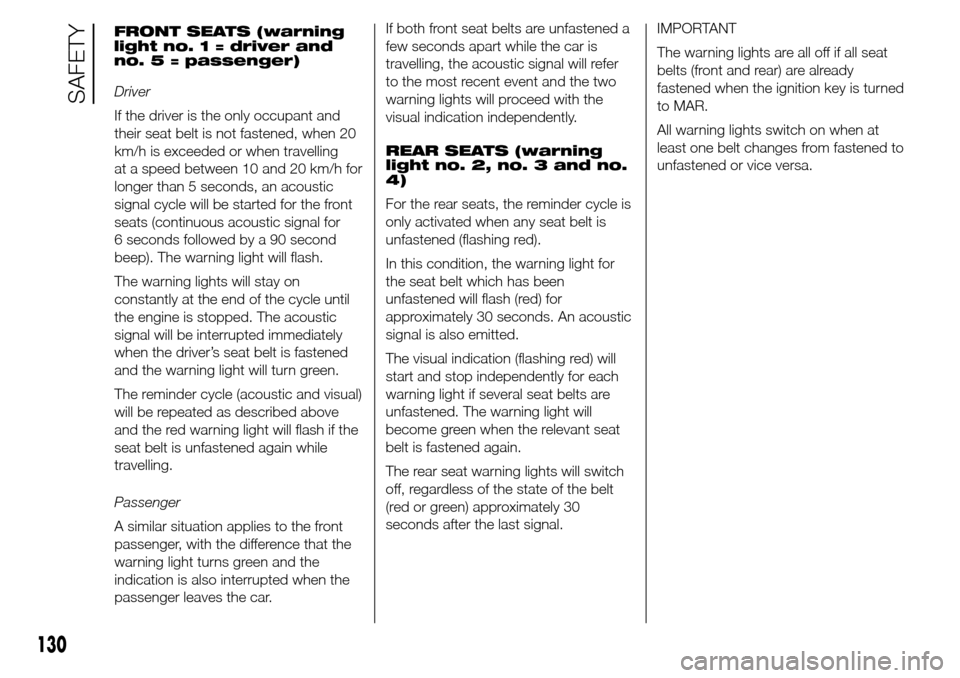
Driver
If the driver is the only occupant and
their seat belt is not fastened, when 20
km/h is exceeded or when travelling
at a speed between 10 and 20 km/h for
longer than 5 seconds, an acoustic
signal cycle will be started for the front
seats (continuous acoustic signal for
6 seconds followed by a 90 second
beep). The warning light will flash.
The warning lights will stay on
constantly at the end of the cycle until
the engine is stopped. The acoustic
signal will be interrupted immediately
when the driver’s seat belt is fastened
and the warning light will turn green.
The reminder cycle (acoustic and visual)
will be repeated as described above
and the red warning light will flash if the
seat belt is unfastened again while
travelling.
Passenger
A similar situation applies to the front
passenger, with the difference that the
warning light turns green and the
indication is also interrupted when the
passenger leaves the car.If both front seat belts are unfastened a
few seconds apart while the car is
travelling, the acoustic signal will refer
to the most recent event and the two
warning lights will proceed with the
visual indication independently.
REAR SEATS (warning
light no. 2, no. 3 and no.
4)
For the rear seats, the reminder cycle is
only activated when any seat belt is
unfastened (flashing red).
In this condition, the warning light for
the seat belt which has been
unfastened will flash (red) for
approximately 30 seconds. An acoustic
signal is also emitted.
The visual indication (flashing red) will
start and stop independently for each
warning light if several seat belts are
unfastened. The warning light will
become green when the relevant seat
belt is fastened again.
The rear seat warning lights will switch
off, regardless of the state of the belt
(red or green) approximately 30
seconds after the last signal.IMPORTANT
The warning lights are all off if all seat
belts (front and rear) are already
fastened when the ignition key is turned
to MAR.
All warning lights switch on when at
least one belt changes from fastened to
unfastened or vice versa.
130
SAFETY
FRONT SEATS (warning
light no. 1 = driver and
no. 5 = passenger)
Page 143 of 288
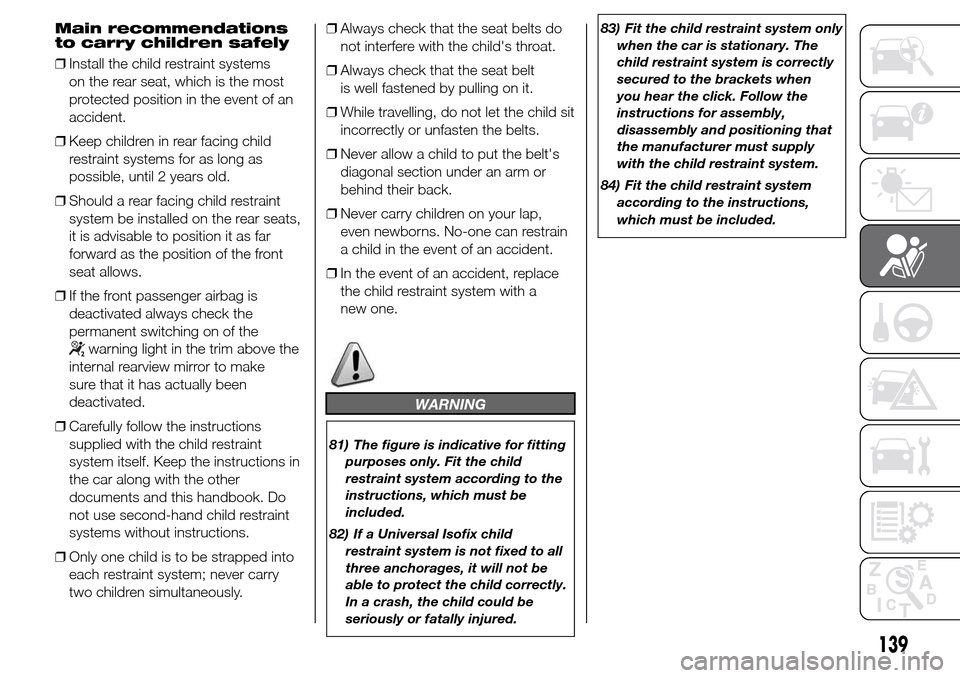
Main recommendations
to carry children safely
❒Install the child restraint systems
on the rear seat, which is the most
protected position in the event of an
accident.
❒Keep children in rear facing child
restraint systems for as long as
possible, until 2 years old.
❒Should a rear facing child restraint
system be installed on the rear seats,
it is advisable to position it as far
forward as the position of the front
seat allows.
❒If the front passenger airbag is
deactivated always check the
permanent switching on of the
warning light in the trim above the
internal rearview mirror to make
sure that it has actually been
deactivated.
❒Carefully follow the instructions
supplied with the child restraint
system itself. Keep the instructions in
the car along with the other
documents and this handbook. Do
not use second-hand child restraint
systems without instructions.
❒Only one child is to be strapped into
each restraint system; never carry
two children simultaneously.❒Always check that the seat belts do
not interfere with the child's throat.
❒Always check that the seat belt
is well fastened by pulling on it.
❒While travelling, do not let the child sit
incorrectly or unfasten the belts.
❒Never allow a child to put the belt's
diagonal section under an arm or
behind their back.
❒Never carry children on your lap,
even newborns. No-one can restrain
a child in the event of an accident.
❒In the event of an accident, replace
the child restraint system with a
new one.
WARNING
81) The figure is indicative for fitting
purposes only. Fit the child
restraint system according to the
instructions, which must be
included.
82) If a Universal Isofix child
restraint system is not fixed to all
three anchorages, it will not be
able to protect the child correctly.
In a crash, the child could be
seriously or fatally injured.83) Fit the child restraint system only
when the car is stationary. The
child restraint system is correctly
secured to the brackets when
you hear the click. Follow the
instructions for assembly,
disassembly and positioning that
the manufacturer must supply
with the child restraint system.
84) Fit the child restraint system
according to the instructions,
which must be included.
139
Page 145 of 288
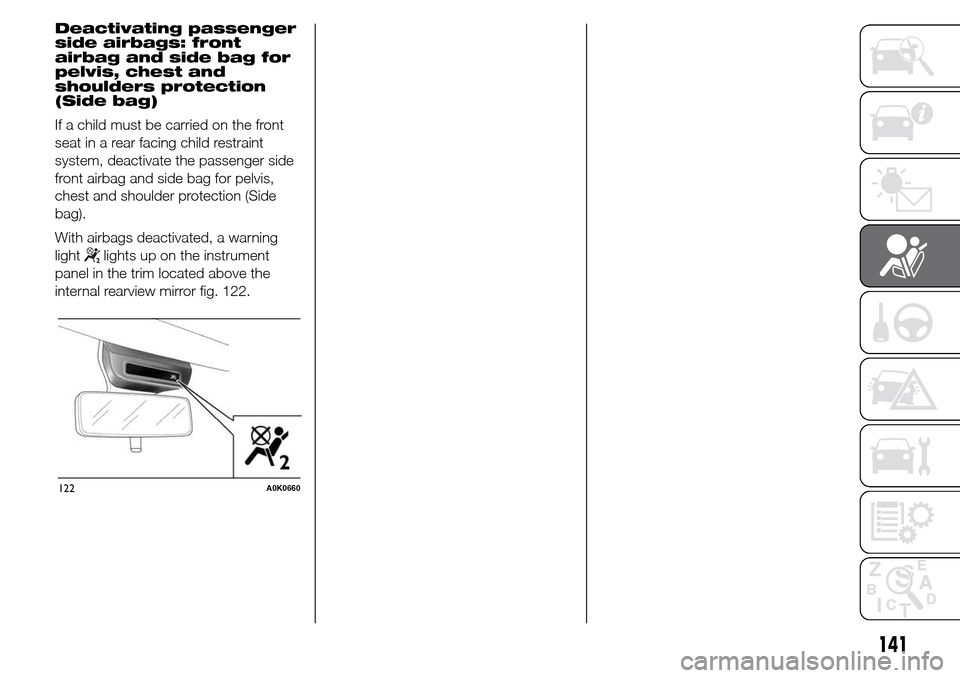
Deactivating passenger
side airbags: front
airbag and side bag for
pelvis, chest and
shoulders protection
(Side bag)
If a child must be carried on the front
seat in a rear facing child restraint
system, deactivate the passenger side
front airbag and side bag for pelvis,
chest and shoulder protection (Side
bag).
With airbags deactivated, a warning
light
lights up on the instrument
panel in the trim located above the
internal rearview mirror fig. 122.
122A0K0660
141
Page 149 of 288
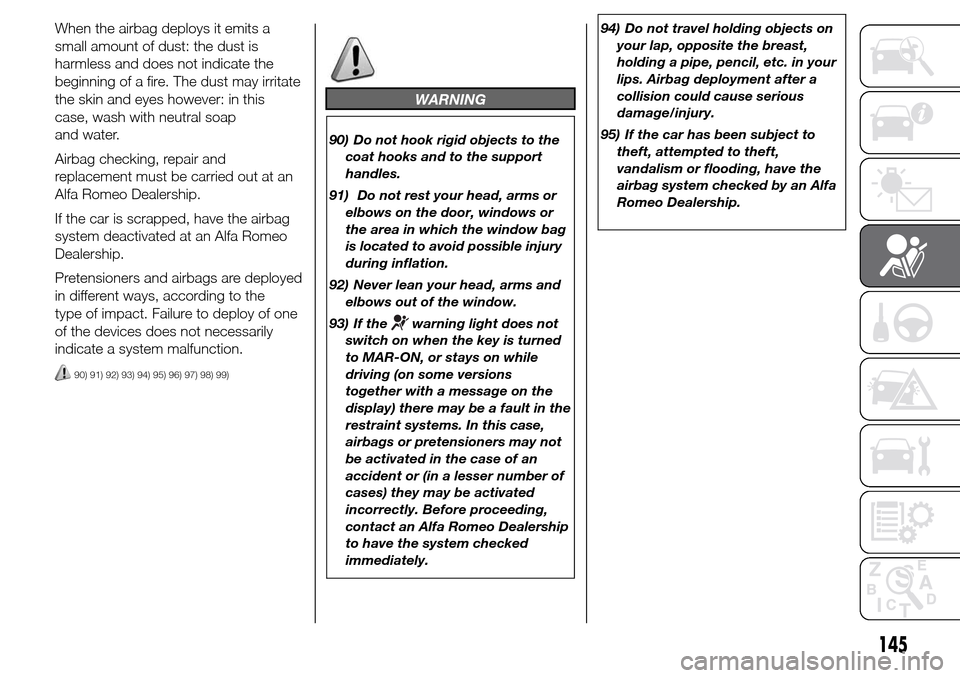
When the airbag deploys it emits a
small amount of dust: the dust is
harmless and does not indicate the
beginning of a fire. The dust may irritate
the skin and eyes however: in this
case, wash with neutral soap
and water.
Airbag checking, repair and
replacement must be carried out at an
Alfa Romeo Dealership.
If the car is scrapped, have the airbag
system deactivated at an Alfa Romeo
Dealership.
Pretensioners and airbags are deployed
in different ways, according to the
type of impact. Failure to deploy of one
of the devices does not necessarily
indicate a system malfunction.
90) 91) 92) 93) 94) 95) 96) 97) 98) 99)
WARNING
90) Do not hook rigid objects to the
coat hooks and to the support
handles.
91) Do not rest your head, arms or
elbows on the door, windows or
the area in which the window bag
is located to avoid possible injury
during inflation.
92) Never lean your head, arms and
elbows out of the window.
93) If the
warning light does not
switch on when the key is turned
to MAR-ON, or stays on while
driving (on some versions
together with a message on the
display) there may be a fault in the
restraint systems. In this case,
airbags or pretensioners may not
be activated in the case of an
accident or (in a lesser number of
cases) they may be activated
incorrectly. Before proceeding,
contact an Alfa Romeo Dealership
to have the system checked
immediately.94) Do not travel holding objects on
your lap, opposite the breast,
holding a pipe, pencil, etc. in your
lips. Airbag deployment after a
collision could cause serious
damage/injury.
95) If the car has been subject to
theft, attempted to theft,
vandalism or flooding, have the
airbag system checked by an Alfa
Romeo Dealership.
145
Page 150 of 288
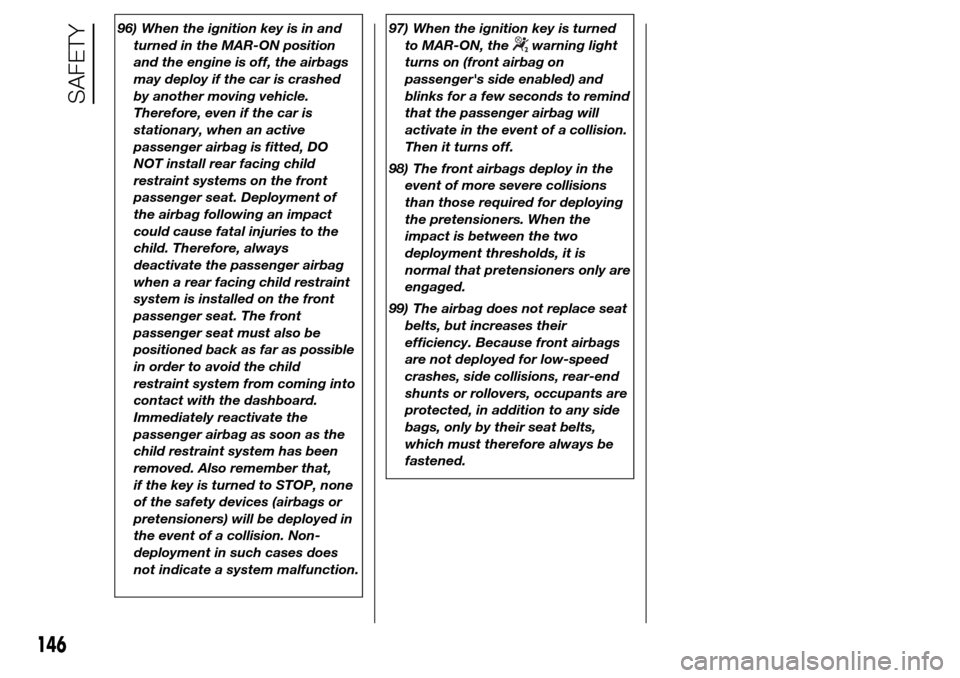
96) When the ignition key is in and
turned in the MAR-ON position
and the engine is off, the airbags
may deploy if the car is crashed
by another moving vehicle.
Therefore, even if the car is
stationary, when an active
passenger airbag is fitted, DO
NOT install rear facing child
restraint systems on the front
passenger seat. Deployment of
the airbag following an impact
could cause fatal injuries to the
child. Therefore, always
deactivate the passenger airbag
when a rear facing child restraint
system is installed on the front
passenger seat. The front
passenger seat must also be
positioned back as far as possible
in order to avoid the child
restraint system from coming into
contact with the dashboard.
Immediately reactivate the
passenger airbag as soon as the
child restraint system has been
removed. Also remember that,
if the key is turned to STOP, none
of the safety devices (airbags or
pretensioners) will be deployed in
the event of a collision. Non-
deployment in such cases does
not indicate a system malfunction.97) When the ignition key is turned
to MAR-ON, the
warning light
turns on (front airbag on
passenger's side enabled) and
blinks for a few seconds to remind
that the passenger airbag will
activate in the event of a collision.
Then it turns off.
98) The front airbags deploy in the
event of more severe collisions
than those required for deploying
the pretensioners. When the
impact is between the two
deployment thresholds, it is
normal that pretensioners only are
engaged.
99) The airbag does not replace seat
belts, but increases their
efficiency. Because front airbags
are not deployed for low-speed
crashes, side collisions, rear-end
shunts or rollovers, occupants are
protected, in addition to any side
bags, only by their seat belts,
which must therefore always be
fastened.
146
SAFETY
Page 152 of 288

STARTING THE
ENGINE
PROCEDURE FOR
PETROL VERSIONS
Proceed as follows:
❒engage the handbrake and place the
gear lever in neutral;
❒fully depress the clutch pedal,
without touching the accelerator;
❒turn the ignition key to AVV and
release it as soon as the engine
starts.
IMPORTANT INFORMATION
100) 101)
102)
16) 17) 18)
❒If the engine does not start at the first
attempt, return the ignition key to
STOP before repeating the starting
procedure.
❒If, when the ignition key is at
MAR-ON, the
instrument panel
warning light (or the symbol on the
display) stays on together with the
warning light, turn the key to
STOP and then back to MAR-ON. If
the warning light (or the symbol on
the display) remains on, try with
the other keys provided with the car.
Contact an Alfa Romeo Dealership
if the engine still does not start.❒Never leave the ignition key at MAR
when the engine is stopped.
PROCEDURE FOR DIESEL
VERSIONS
Proceed as follows:
19)
❒engage the handbrake and place the
gear lever in neutral;
❒turn the ignition key to MAR-ON: the
warning lights
andon the
instrument panel will turn on (for
versions/markets, where provided);
❒wait for the warning lights to switch
off;
❒fully depress the clutch pedal,
without touching the accelerator;
❒turn the ignition key to AVV as soon
as warning light
switches off.
Waiting too long will waste the
heating work carried out by the glow
plugs. Release the key as soon as
the engine starts.
WARMING UP THE
ENGINE JUST AFTER IT
HAS STARTED
Proceed as follows:
❒drive off slowly, letting the engine turn
at medium speed without
accelerating abruptly;❒do not demand full performance at
first. It is advisable to wait until the
engine coolant temperature indicator
starts moving.
STOPPING THE ENGINE
Turn the ignition key to STOP while the
engine is idling.
IMPORTANT After a demanding drive,
before turning the engine off you should
let it idle so that the temperature in the
engine compartment decreases.
WARNING
100) It is dangerous to run the
engine in enclosed areas. The
engine takes in oxygen and
releases carbon dioxide, carbon
monoxide and other toxic gases.
101) The brake servo is not active
until the engine is started, so
you would need to apply much
more force than usual to the
brake pedal.
102) Do not start the engine by
pushing, towing or driving
downhill. These manoeuvres may
damage the catalytic converter.
148
STARTING AND DRIVING